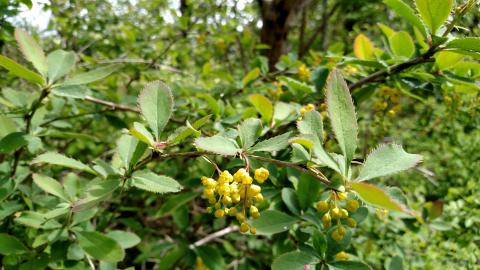Invasive in the Spotlight: European Barberry

European barberry (Berberis vulgaris) is native to Eurasia. Colonial immigrants introduced European barberry to New England for its bark’s reputed medicinal qualities and nutritional properties. Barberry fruits contain rich amounts of Vitamin C, Malic acid and tannins. Although European barberry is not very common in the landscape in New Hampshire, it can grow so aggressively that it is classified as prohibited species. In addition, European barberry is of particular concern because it is an alternate host of stem rust, which is a serious disease of cereal crops that dramatically reduces yields. Eradicating European barberry reduces the occurrence of stem rust on these crops.
Description
European barberry is a shrub that grows to be 3’ to 8’ high and wide, and has tan bark with 3 long spines at each leaf axis. Its leaves are finely toothed, alternate, simple, ½” – 1 ½” long, and bright green on top while dull green on the bottom. Trailing yellow flowers develop mid-April to May.
As fall approaches, fleshy red drupes appear at the ends of the branches, which are edible and are commonly used to create barberry jellies. Each fruit contains about 2-3 seeds, which are dispersed by birds, small mammals, and running water, if the shrubs are growing near rivers or streams. The seeds can remain viable in the soil for nine or more years.
European barberry is hardy in USDA zones 4 thru 8 and prefers full sun to partial shade, tolerating a variety of environments. Although it can sustain itself in a variety of soil types, it grows best in alkaline soils. European barberry is also very tolerant of pollution.
Control
European barberry is best controlled with an Integrated Pest Management (IPM) approach for woody invasive plants.
Hand pull young plants in the spring or fall after rain events, when the ground is softer and it is easier to remove the roots.
Repeatedly mowing plants to the ground can also be very effective if done on a routine basis - at least four times during the growing season. Larger, older plants can be controlled by cutting them at the base with a handsaw or chainsaw to prevent re-sprouting.
Herbicides can be used to control large populations. Foliar sprays of glyphosate products can be effective in late September through November, being careful to only apply the herbicide to barberry leaves. Glyphosate is non-selective and can damage other non-target plants. Another option is to cut barberry to the ground and apply an herbicide to the cut stump in early summer through winter.
Cultural methods can also be used to help keep barberry under control. One cultural control method is to plant large shrubs or trees in areas infested with European Barberry to block sunlight to the shrubs and limit their growth.
Alternatives
Many attractive non-invasive shrubs are good alternatives to barberry. Weigela (Weigela florida) ‘Alexandra’, ‘Elvera’, ‘Minuet’, and ‘Tango,’ common ninebark (Physocarpus opulifolius), bayberry (Myrica pensylvanica), inkberry (Ilex glabra), and Virginia sweetspire (Itea virginica) are all attractive substitutes that can perform a similar function in the landscape to European barberry.



.jpg)
UNH Cooperative Extension Master Gardener volunteers share information about home, yard, and garden topics with the people of New Hampshire. Got questions? Master Gardeners provide practical help finding answers to your questions through the Ask UNH Extension Infoline. Call toll free at 1-877-398-4769, Monday to Friday, 9 a.m. to 2 p.m., or e-mail us at answers@unh.edu.
Related Resource(s)
Do you love learning about stuff like this?
SUBSCRIBE TO Granite State Gardening newsletter
Got questions? The UNH Extension Yard and Garden Infoline offers practical help finding answers for your yard and garden questions.
Call toll free at 1-877-398-4769, Monday to Friday, 9 a.m. to 2 p.m., or fill out webform.

